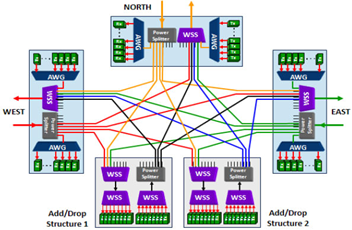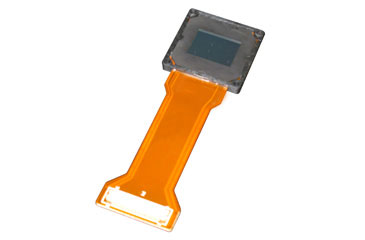LCOS chip and optical device / LCOS chip and optical device
LCOS chip and optical device
(1)Wavelength Selective Switch (WSS)
The Wavelength Selective Switch (WSS) is the core module of the Reconfigurable Optical Add/Drop Multiplexing (ROADM). The importance of the WSS to ROADM is equivalent to the CPU of PC. ROADMs require multiple WSS devices depending on the different usage scenario and specifications. As one of the most important components of the all-optical network, ROADM can bring flexibility to the optical network, reduce power consumption and cost, also make full use of network idle resources. In the implementation of low-latency transmission and switching, the WSS-based ROADM has become an important technology implementation in optical industry.

Typical ROADM structure
(2)LCOS chip for WSS
At present, with the evolution of optical fiber communication technology, higher requirements are placed on WSS-based ROADM. CDC-F (direction independent, wavelength independent, competition independent, and flexible bandwidth support) ROADM is more and more important, and based on LCOS implementation, WSS has become a mainstream solution due to its high flexibility.
There are three main technical solutions of WSS: MEMS, LCOS, and LC. The technical characteristics comparison are as follow:
| No. | Technical solutions | Characteristics | Flexgrid | Application prospect |
|---|---|---|---|---|
| 1 | MEMS | simple light path, low loss , good port expandability | not supported | Limited application |
| 2 | LCOS | complicated optical path, high loss, good port expandability. | Supported | Mainstream |
| 3 | LC | complicated optical path, low loss, poor port expandability. | Supported | Limited application |
LCOS-based WSS has profoundly affected the design of ROADM systems. In the past, MEMS-based WSS needed to define the interval of each channel in advance (for example, 100 GHz or 50 GHz), and then it could not be changed. However, the millions of pixels on the LCOS can arbitrarily change the spacing of each channel. In the era of over 100 G bit/s, the frequency resources are fully utilized to improve the spectral efficiency, and the era of flexible grids is opened.
The flexibility of the WSS scheme through LCOS technology is quite high. While the phase change changes the direction of the light, the phase adjustment can also be used to correct the dispersion. In addition to compensating for the dispersion, there are many things that can be done by phase modulation, such as pulse shaping. In addition, LCOS-based WSS has the following distinct advantages: flexible spectrum coverage, adaptive alignment, and stability. The M×N WSS implemented by LCOS technology belongs to the third generation ROADM and is the current research hotspot. It aims to increase the number of ports and improve performance.

LCOS chip
(3)Application of WSS based on LCOS in 5G
5G brings new opportunities and challenges to the development of optical communications. The entire industry, such as fiber optics, optical modules, and optical access network systems, will benefit from 5G construction. The 5G architecture will enable the backhaul/intermediate/previous transmission capacity to expand dozens of times, reaching tens of hundreds of Gbps. In the process of 5G network construction, the 5G base station solves the problem of high-speed access, but the low-latency requirement of 5G still needs to be upgraded and expanded to support the fiber network. To improve network configuration efficiency and reduce delay, a new generation optical network is required to be an intelligent network. Network reconstruction can be implemented based on SDN (Software Defined Network). The SDN network can be reconfigured according to software settings. Manual operation can be achieved through ROADM. The focus of the fiber network upgrade is the metropolitan area network. The current metropolitan area network is mainly based on FOADM (Fixed Optical Add-Drop Multiplexer) technology. It’s necessary to let the ROADM technology for the backbone network will sink to the metropolitan area network, which will brings ROADM and Its core device, WSSexplosive growth in market demand.
With the higer requirements of 5G for all-optical networks, LCOS WSS, which provides high port count and flexible bandwidth, has become mainstream,.mainly because of its high flexibility, flexible spectrum coverage, adaptive alignment capability and high stability. But the high-port WSS (1X32, 1X64 and above) only applied LCOS technology and a very limited number of vendors.
